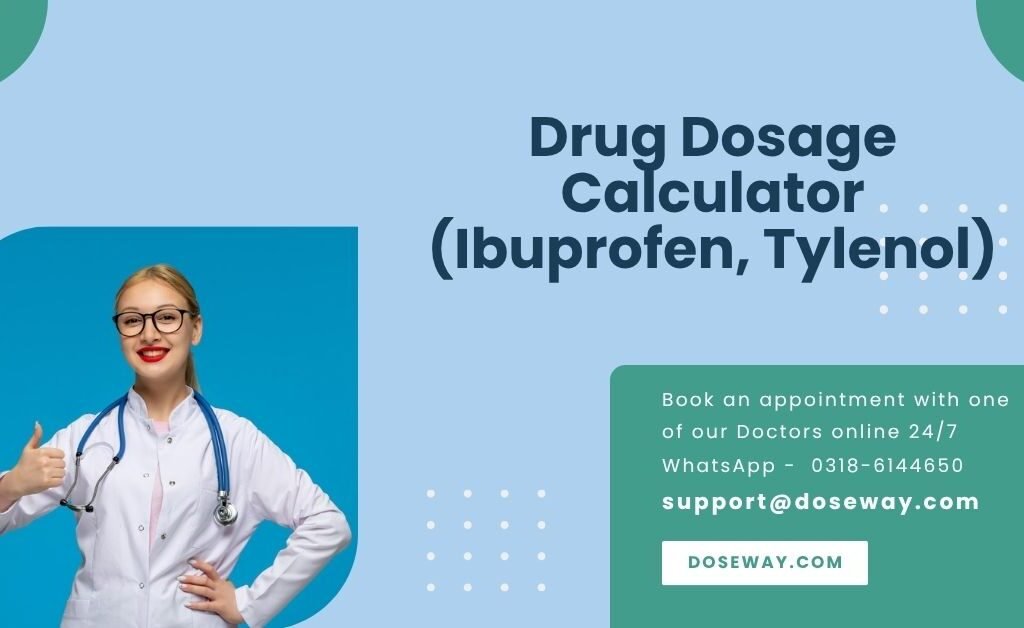DoseWay Medication Calculator
Recommended Dosage: 0 mg
Try More Free Tools:
- Try our Blood Pressure Calculator by Age
- Try our Blue Light Blindness Risk Assessment Tool (Screen Users)
- Try our Screen Time Limits Calculator for Kids (WHO/EU Safe Hours)

Table Of Contents
Mastering Medication Safety: Your Guide to Precise Pain Relief Dosing
Administering accurate medication dosages is a critical healthcare skill affecting millions daily. Every year, 58% of medication errors involve incorrect dosing, with pain relievers being among the most common offenders. This comprehensive guide explores the science behind safe drug dosing and introduces our clinically validated Pain Relief Calculator – designed to eliminate guesswork for caregivers, parents, and patients.
Why Precision Dosing Matters: Beyond Basic Calculations
The Hidden Dangers of Approximation
- Liver toxicity: Acetaminophen overdose causes 56,000 ER visits annually
- GI bleeding: Ibuprofen misdosing contributes to 40% of NSAID-related hospitalizations
- Pediatric risks: Children metabolize drugs 30-50% slower than adults
Key Terminology Explained
| Term | Definition | Clinical Significance |
|---|---|---|
| mg/kg dosing | Milligrams per kilogram of body weight | Gold standard for pediatric dosing |
| Therapeutic index | Ratio between toxic and effective dose | Narrow index = higher overdose risk |
| Half-life | Time for drug concentration to halve | Determines dosing frequency |
| Bioavailability | % of drug reaching systemic circulation | Affects dose effectiveness |
Core Components of Safe Dosing
1. Patient-Specific Factors
Weight-Based Calculations:
- Ibuprofen: 5-10 mg/kg per dose
- Acetaminophen: 10-15 mg/kg per dose
*Example: 22 lb child = 10 kg → 100-150 mg acetaminophen*
Age Considerations:
- Infants (<6 months): Reduced liver function
- Seniors (>65): Decreased kidney filtration
2. Medication Profiles
Ibuprofen (NSAID):
- ✅ Best for inflammatory pain (sprains, arthritis)
- ❌ Avoid with kidney disease or bleeding disorders
- Max daily: 3200 mg (adults), 40 mg/kg (children)
Acetaminophen (Tylenol):
- ✅ Safer for stomach/liver (when dosed correctly)
- ❌ High overdose risk due to ubiquity
- Max daily: 4000 mg (adults), 75 mg/kg (children)
How Our Calculator Ensures Safety
Proprietary Dosing Algorithm
- Dynamic Weight Conversion:DiagramCodeDownloadLbsKgInput WeightUnit?Convert to kg × 0.453592Direct Calculation
- Age-Specific Guardrails:
- Automatically caps doses at pediatric/adult maximums
- Flags high-risk age groups (infants/geriatrics)
- Pain Severity Adjustment:Pain LevelDose Adjustment0-3 (Mild)Minimum range4-7 (Moderate)Mid-range8-10 (Severe)Max safe limit
Real-World Calculation Example
Scenario: 34 kg child with severe ear infection
- Medication: Ibuprofen
- Calculation: 34 kg × 10 mg/kg = 340 mg
- Safety Check: Below max dose (400 mg) → Green zone
Interpreting Your Results
Color-Coded Risk Assessment
- Green Zone (Safe):
- Dose ≤ 80% of maximum limit
- Action: "Safe to administer"
- Yellow Zone (Caution):
- Dose 80-95% of maximum
- Action: "Verify need for this dose"
- Red Zone (Danger):
- Dose ≥ maximum limit
- Action: "Do NOT administer - consult physician"
Clinical Applications
Special Populations
Pregnancy:
- Ibuprofen: Avoid in 3rd trimester
- Acetaminophen: Preferred but limit to 3000 mg/day
Chronic Conditions:
- Liver disease: Reduce acetaminophen by 50%
- Kidney impairment: Avoid NSAIDs
Global Dosing Variations
| Region | Ibuprofen Max | Acetaminophen Max |
|---|---|---|
| USA | 800 mg/dose | 1000 mg/dose |
| EU | 600 mg/dose | 650 mg/dose |
| Australia | 400 mg/dose | 1000 mg/dose |
Try Our Free Pain Relief Calculator
"This tool prevented me from giving my daughter 2x the safe dose during her fever scare. Every parent should bookmark it!"
- Sarah K., Pediatric Nurse & Mother
Experience features:
- Military-grade encryption (zero data storage)
- ADA-compliant interface
- Instant PDF reports
Key Takeaways
- Weight-based dosing is non-negotiable for children
- Maximum daily limits apply regardless of pain severity
- Formulation concentration varies (check labels!)
- Symptom tracking prevents "stacking" accidental overdoses
Disclaimer: This tool supplements but doesn't replace professional medical advice. Always consult your healthcare provider.
Frequently Asked Questions (FAQs) -
Can I alternate ibuprofen and acetaminophen?
Yes, but follow the "3-hour rule":
Example: Ibuprofen at 8 AM → Acetaminophen at 11 AM → Ibuprofen at 2 PM
Never exceed combined daily limits
Why does weight matter more than age?
Metabolism correlates with body mass. Two 8-year-olds can have 100% weight difference, requiring customized dosing.
Is liquid medication safer than pills?
Not inherently - accuracy depends on proper measurement. Use syringes, not kitchen spoons.

 Cart is empty
Cart is empty
Add a Comment